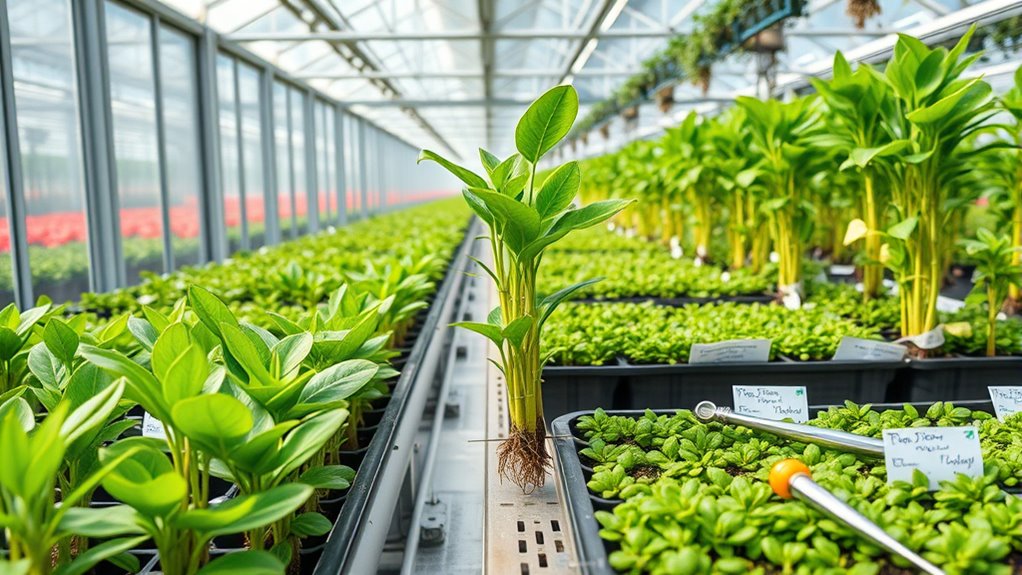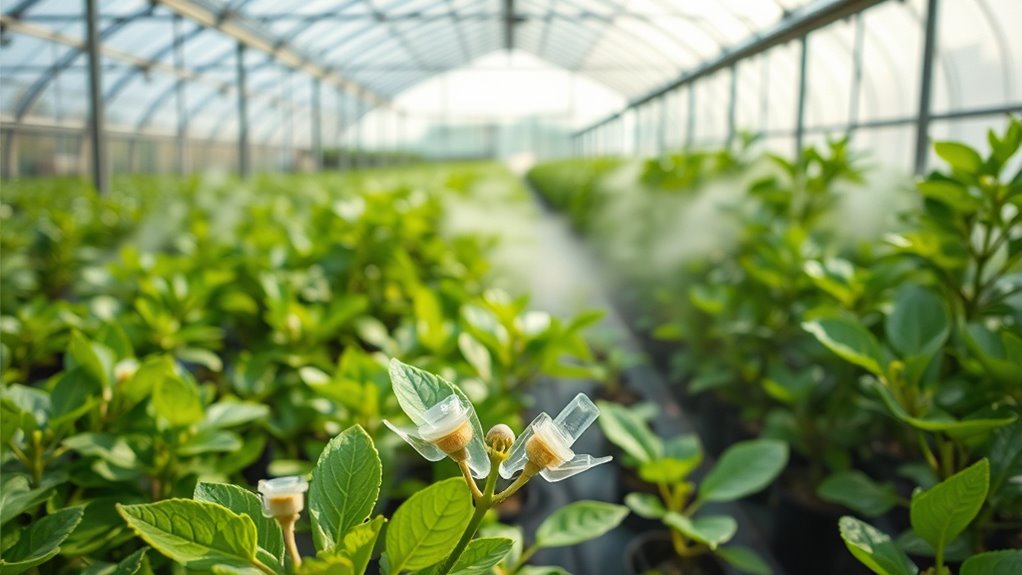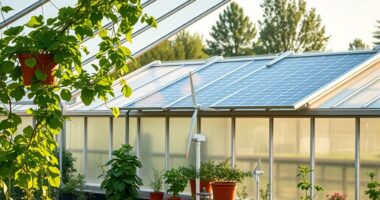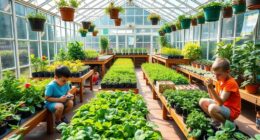Greenhouse grafting and cloning help you produce healthy, uniform plants by creating ideal conditions for growth. You control temperature, humidity, and protect plants from pests and diseases, which boosts success rates. Selecting the right rootstock improves resistance and vigor, while compatible grafts ensure strong nutrient flow. Cloning maintains desirable traits for high yields and quality. Keep exploring these techniques, and you’ll discover how to optimize your propagation processes for better results.
Key Takeaways
- Greenhouses provide controlled environments ideal for precise grafting and cloning, ensuring optimal conditions for plant development.
- Selecting compatible, disease-resistant rootstocks enhances grafting success and plant resilience.
- Proper techniques and sterile conditions are essential for effective cloning and preventing disease transmission.
- Greenhouse propagation ensures consistent quality, vigor, and high yields through controlled temperature and humidity.
- Combining grafting with cloning promotes healthy, high-performing plants with desired genetic traits and disease resistance.

Greenhouses provide an ideal environment for grafting and cloning, allowing gardeners and growers to efficiently propagate healthy, high-yielding plants. This controlled setting ensures optimal temperature, humidity, and protection from pests and diseases, which are essential for successful propagation. When you’re working on grafting, selecting the right rootstock is crucial. The rootstock acts as the foundation of the plant, influencing its overall health, growth rate, and disease resistance. By choosing a rootstock with proven disease resistance, you increase the chances of producing resilient plants that can withstand common pathogens and environmental stresses. This strategic selection minimizes the risk of disease outbreaks and reduces the need for chemical treatments, making your operation more sustainable and cost-effective. Proper compatibility between the rootstock and scion is vital for ensuring strong vascular connections, which are essential for efficient nutrient flow and plant vigor. In your grafting process, you’ll want to pay close attention to the compatibility between the rootstock and the scion. Proper matching ensures strong vascular connections, which are vital for nutrient flow and overall plant vigor. The right rootstock not only enhances disease resistance but also influences root system strength, drought tolerance, and nutrient uptake. When you select a rootstock suited to your specific environment and crop needs, you’re setting a solid foundation for healthy, productive plants. The improved disease resistance provided by the right rootstock can lead to fewer losses and less effort spent on managing plant health issues. Cloning in greenhouses complements grafting by allowing you to reproduce plants with identical genetic traits. This process ensures consistency in quality, flavor, and yield, especially in commercial operations. When you clone, you maintain desirable characteristics, such as pest resistance or specific fruit qualities, across all your plants. Proper cloning techniques, combined with the ideal greenhouse environment, help prevent disease transmission and promote vigorous growth. It’s essential to maintain sterile conditions during cloning to avoid introducing pathogens that could compromise your plants’ health. Using disease-resistant stock and clean tools further safeguards your clones during propagation. Incorporating disease-resistant rootstocks can further enhance the resilience of your propagated plants, reducing the risk of infections and increasing overall success rates.
Frequently Asked Questions
What Are the Best Greenhouse Conditions for Successful Grafting?
To guarantee successful grafting, you need to optimize greenhouse conditions. Maintain humidity control around 90% to prevent the graft from drying out, and keep temperature regulation steady between 20-25°C (68-77°F) to promote healing. You should also avoid sudden temperature fluctuations and ensure good air circulation. These conditions help the graft union develop strong, healthy connections, increasing your chances of a successful graft.
How Long Does Cloning Typically Take to Produce Mature Plants?
You might think cloning plants is instant, but the cloning timeline actually tests your patience. Typically, it takes anywhere from a few weeks to several months for clones to reach maturity development. During this period, you’ll watch tiny cuttings grow roots, develop leaves, and inch closer to full size. So, if you’re enthusiastic for instant results, remember that nurturing clones demands patience and care before they become fully mature plants.
Can Grafting Be Performed on All Plant Species in Greenhouses?
Grafting can’t be performed on all plant species in greenhouses because of species compatibility and grafting limitations. You need to verify the plants are closely related; otherwise, the graft may fail. Some species, especially woody or broadleaf plants, respond well, but others, like certain herbs or annuals, don’t. Always check compatibility and limitations before attempting grafting, so you avoid wasting time and resources on incompatible plants.
What Are Common Mistakes to Avoid During Grafting and Cloning?
Ever wonder what mistakes can ruin your grafting or cloning efforts? You should avoid graft incompatibility by choosing compatible plant varieties, and always prioritize contamination prevention. Be careful not to damage the cambium layer, as poor cuts weaken the bond. Also, don’t overlook proper sterilization of tools—contaminants can infect your plants. These steps guarantee successful grafts and clones, saving you time and resources.
How Do I Ensure Genetic Stability in Cloned Plants?
To guarantee genetic stability in cloned plants, you need to focus on maintaining genetic fidelity throughout the process. Always verify clones through clone verification methods to confirm they match the parent plant. Use healthy, disease-free stock and follow strict protocols during cloning to prevent genetic variation. Regularly monitor your clones and document their traits to catch any deviations early, ensuring consistent quality and uniformity in your plants.
Conclusion
By mastering grafting and cloning techniques, you can boost your greenhouse’s productivity. Did you know that cloned plants can grow 20% faster than seed-grown ones? This means quicker harvests and increased yields. Whether you’re propagating high-demand crops or experimenting with new varieties, these methods give you control and consistency. Embrace advanced propagation, and watch your greenhouse thrive with healthier, more uniform plants—making your gardening efforts more rewarding and efficient.









